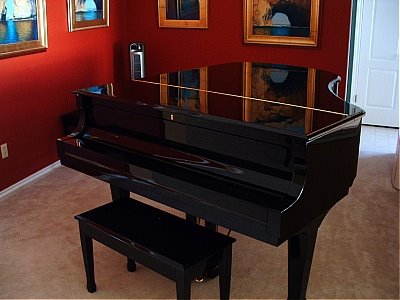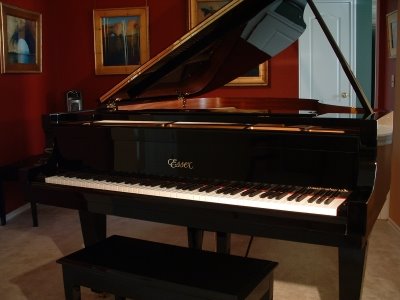The Maiden and the Nightingale (Quejas ó la Maja y el Ruiseñor) is the fourth piece in Enrique Granados' Goyescas suite for piano. It's not really fair to say that one piece of music is "better" than another, but I think it's probably safe to say that Goyescas is the best music ever written by anybody.
I like to think of Maiden as a battle between a young maiden who is determined to be dark and dramatic and a little bird intent on pulling her out of her funk. You can hear the bird fluttering in and out through most of the piece. But you'll have to listen through to the end to find out who wins.
Granados: Laments or The Maiden and the Nightingale from Ken Barker on Vimeo.
Tuesday, December 30, 2008
Sunday, December 28, 2008
Video: Pathétique Sonata, 2nd Movement
This is the second movement (Adagio Cantabile) of Ludwig van Beethoven's Pathétique Sonata (Sonata No. 8). It's another piece my mother used to play that has always stuck with me. I decided to learn it because it's a (relatively) simple way to add entertainment to the repertoire. Many people recognize and love the piece. Even if you've never heard it, it's recognizable because it's been "quoted" a lot in popular music.
As I mentioned in my previous post, I've made some changes to my recording setup. Better lighting makes the video a little clearer. Better mic pres and converters make the audio much better, and I'm recording in stereo. But the biggest improvement is probably due to using a different video hosting service. YouTube is great for quantity and variety, but the video and audio quality are terrible. Google Video was supposed to be better, allowing higher resolution and stereo audio. But after uploading the video I found it was no better than YouTube. I finally settled on Vimeo. I love this site. They actually play the video at the quality of the uploaded file! Brilliant!
So here goes... let's hope the embedding works properly.
Beethoven Pathétique Sonata (2nd Movement) from Ken Barker on Vimeo.
As I mentioned in my previous post, I've made some changes to my recording setup. Better lighting makes the video a little clearer. Better mic pres and converters make the audio much better, and I'm recording in stereo. But the biggest improvement is probably due to using a different video hosting service. YouTube is great for quantity and variety, but the video and audio quality are terrible. Google Video was supposed to be better, allowing higher resolution and stereo audio. But after uploading the video I found it was no better than YouTube. I finally settled on Vimeo. I love this site. They actually play the video at the quality of the uploaded file! Brilliant!
So here goes... let's hope the embedding works properly.
Beethoven Pathétique Sonata (2nd Movement) from Ken Barker on Vimeo.
Saturday, December 27, 2008
Art Facts Video -- Take 2
I was pretty disappointed with my first attempts at piano video. The audio quality was nasty, the video was iffy, and of course, YouTube does its best to convert mediocre to horrible. So I'm trying again, attempting improvements on all three fronts. Johanne bought me new mic pres and converters for Christmas, so the audio should be much better. I picked up a thousand watts of lighting to improve the video. And I'm going to try streaming off of Google Video instead of YouTube, so I can at least have stereo audio in the video.
I'll post the first new video as soon as Google has finished processing it. In the meanwhile, here's a picture of my recording setup. In the photo, my new lights, my Essex with two AKG mics on it, and on the half-wall, left-to-right: hygrometer, metronome, headphones, Lexicon Omega (mic pres and converters), trackball, keyboard, monitor. Of course, Johanne's paintings hang off the picture rail, with a couple of gaps for the recently sold.

I'll post the first new video as soon as Google has finished processing it. In the meanwhile, here's a picture of my recording setup. In the photo, my new lights, my Essex with two AKG mics on it, and on the half-wall, left-to-right: hygrometer, metronome, headphones, Lexicon Omega (mic pres and converters), trackball, keyboard, monitor. Of course, Johanne's paintings hang off the picture rail, with a couple of gaps for the recently sold.

Sunday, December 7, 2008
2x: Finding Twice the Usual (P.S.)

Just noticed that Twice the Usual is also available on Amazon.com. You can download the whole album or individual songs. These are mp3 versions, so the sound quality won't be as good as if you buy the physical CD from Thom's website. But it's still pretty cool to see the album on Amazon.
Friday, December 5, 2008
2x: Finding Twice the Usual
What would prompt me to blog about 2x after almost a full year since the last post?
Two things.
First, after the album was manufactured/released, I took down the unmastered recordings linked from this blog. That's because Thom is trying to recoup some of the costs of production (by selling the album instead of giving it away free). It's also because the recordings were unmastered, and considerably inferior to the finished product. But I still get some clicks on those audio links, so I thought I'd make the album a little easier to find. The links now take you to the 404 page at art-facts.com, which itself now has a link to Thom's website, where you can buy the album.
Second, I never blogged about the mastering session. It's definitely blogworthy (a low bar, admittedly), but not today. Short version: I took the recordings to Nick Landis at Terra Nova Mastering. Terra Nova is one of the premier mastering houses anywhere, and Nick has ears the size of satellite dishes. Going to him was kind of like asking Picasso to put some finishing touches on your pencil doodles: he'll probably make some great improvements, but bring a mop and bucket for your self-esteem.
To be continued....
Two things.
First, after the album was manufactured/released, I took down the unmastered recordings linked from this blog. That's because Thom is trying to recoup some of the costs of production (by selling the album instead of giving it away free). It's also because the recordings were unmastered, and considerably inferior to the finished product. But I still get some clicks on those audio links, so I thought I'd make the album a little easier to find. The links now take you to the 404 page at art-facts.com, which itself now has a link to Thom's website, where you can buy the album.
Second, I never blogged about the mastering session. It's definitely blogworthy (a low bar, admittedly), but not today. Short version: I took the recordings to Nick Landis at Terra Nova Mastering. Terra Nova is one of the premier mastering houses anywhere, and Nick has ears the size of satellite dishes. Going to him was kind of like asking Picasso to put some finishing touches on your pencil doodles: he'll probably make some great improvements, but bring a mop and bucket for your self-esteem.
To be continued....
Friday, November 28, 2008
Art Facts Facelift
I'm fooling around with a new look for the blog.
Leave a comment if you like it or if it makes your brain bleed. (And let me know what browser you're using, especially if it looks hinky).
And be sure to check out the new "Labels" menu below the "Blog Archive" on the right. I went back and put labels on all the old blog posts. Now you can jump directly to all posts with audio, or all posts about recitals, etc.
Leave a comment if you like it or if it makes your brain bleed. (And let me know what browser you're using, especially if it looks hinky).
And be sure to check out the new "Labels" menu below the "Blog Archive" on the right. I went back and put labels on all the old blog posts. Now you can jump directly to all posts with audio, or all posts about recitals, etc.
Thursday, November 27, 2008
Repertoire and the After-Work Musician
Professional musicians often list their repertoire on their websites. Sometimes I look at these lists and think: how can you have 100 pieces up to performance level? Well, I guess if you practice 8 hours a day you could run through that repertoire beginning-to-end once a week and still have 5 days to really practice.
But what about us working shlubs? Is it possible to build (and maintain) a decent repertoire with 8 hours of practice a week?
Last November I was struggling just to get two pieces up to performance level. When I finally got them, others started to come more easily. I now have 13 pieces at performance level. But I certainly can't run through all of them every day, or even every two days and still hope to work on rough spots or new stuff.
But I'm finding that while some pieces need constant attention, others can go several days without playing. And when I do play them, the trouble spots are immediately obvious, because they're the spots that don't survive several days' neglect. So in a way, my practice is more focused.
To make this work, I keep a one-page chart with all the pieces I know (and new ones I'm learning) listed down the left, and the days of the month along the top. Every day I put codes in the grid for the pieces I worked on. If I simply played through a performance of the piece from memory, I put a "P" in the grid. If I worked on the piece, it gets a "W". If I played through with the music it gets an "M". So when I sit down to practice, I can look at the chart and see which pieces have gone the longest without attention.
Anyway, it seems to be working really well. I'm pretty confident that I could pull a full recital program together with about a week's notice. And I can certainly sit down and play a piece or two if people ask... and probably something different from the last time I played for them. I'm also making progress on 3 or 4 new pieces.
I'm curious to see how far this routine will take me. Will it continue to work with 20 pieces? 25? Or am I already at the limit for the number of hours I put in?
But what about us working shlubs? Is it possible to build (and maintain) a decent repertoire with 8 hours of practice a week?
Last November I was struggling just to get two pieces up to performance level. When I finally got them, others started to come more easily. I now have 13 pieces at performance level. But I certainly can't run through all of them every day, or even every two days and still hope to work on rough spots or new stuff.
But I'm finding that while some pieces need constant attention, others can go several days without playing. And when I do play them, the trouble spots are immediately obvious, because they're the spots that don't survive several days' neglect. So in a way, my practice is more focused.
To make this work, I keep a one-page chart with all the pieces I know (and new ones I'm learning) listed down the left, and the days of the month along the top. Every day I put codes in the grid for the pieces I worked on. If I simply played through a performance of the piece from memory, I put a "P" in the grid. If I worked on the piece, it gets a "W". If I played through with the music it gets an "M". So when I sit down to practice, I can look at the chart and see which pieces have gone the longest without attention.
Anyway, it seems to be working really well. I'm pretty confident that I could pull a full recital program together with about a week's notice. And I can certainly sit down and play a piece or two if people ask... and probably something different from the last time I played for them. I'm also making progress on 3 or 4 new pieces.
I'm curious to see how far this routine will take me. Will it continue to work with 20 pieces? 25? Or am I already at the limit for the number of hours I put in?
Saturday, October 25, 2008
ConcART Review
The party was a great success. In total, we had about 65 people show up over the four hours, and Johanne sold six pieces. 50 people came in time for the recital, almost all of them arriving in a flood between 1:00pm and 1:05pm. They took their seats right away and by 1:15pm we had a packed house and were ready to start on time.
I gave a little introductory spiel and then launched into the program. Luckily, the people who came were interested in hearing a classical piano recital. So we had a very attentive and very appreciative audience of 50 crammed into our living room. And I think their attentiveness rubbed off, because I was able to focus intently on the music and it went great. I'd say it was one of my best performances ever.
A couple of highlights...
I gave a little introductory spiel and then launched into the program. Luckily, the people who came were interested in hearing a classical piano recital. So we had a very attentive and very appreciative audience of 50 crammed into our living room. And I think their attentiveness rubbed off, because I was able to focus intently on the music and it went great. I'd say it was one of my best performances ever.
A couple of highlights...
- Many people commented that they appreciated the little stories I told before each piece. Instrumental music can sometimes be pretty abstract, so if you know to "listen for the little bird fluttering in and out" or "the right hand is supposed to sound like water cascading over rocks", it adds a more concrete dimension.
- I was most worried about The Maiden and the Nightingale, since it's a difficult piece and this was my first real performance of it. But it went great. I described it as a battle between the maiden trying to be dark and dramatic and the happy little nightingale trying to snap her out of it. I suggested that people listen and decide for themselves who wins the battle. Later, one of the guests wrote in the guestbook: "The nightingale got the last word!"
- The Danzas Argentinas are always a great way to end a program. The big build up to the final, piano-wide up-down glissando and crashing cadence puts an exclamation mark on everything. The audience responded with laughs and shouts and a blast of applause that seemed to go on and on.
- Gary, for tuning and adjusting the piano
- Libby, for handling the art sales
- Laura, for working the back door during the recital
- Melissa and Debie, for keeping the food and drink areas stocked and clean during the party
Friday, October 3, 2008
ConcART!

On Sunday, October 19, Johanne will be having her first solo Art Show at our home here in Austin. The show will feature her latest pastel painting series on Rocher Percé, her new wood burnings and a couple of new wood sculptures.
 To kick off the show, I'll be giving a recital on my new piano. We're expecting 40-50 people. (If you're in Austin, or think you could make it and didn't receive an invitation, let me know. I'll get one out to you).
To kick off the show, I'll be giving a recital on my new piano. We're expecting 40-50 people. (If you're in Austin, or think you could make it and didn't receive an invitation, let me know. I'll get one out to you).
I wanted to give a longish recital. Most other opportunities involve multiple performers where each is limited to one or two pieces. This is an opportunity to stretch out a little and design a nice program with some variety. The problem is that when I laid it out, it was too long. And removing pieces is a sad thing. But after much hair-pulling, I've whittled it down to...
1. El Puerto (Albéniz)
2. Sonetto 104 del Petrarca (Liszt)
3. Sonata No.8 (Pathétique), 2nd movement (Beethoven)
4. Impromptu Op.90, No.4 (Schubert)
5. Quejas, ó la Maja y el Ruiseñor (Granados)
6. Danzas Argentinas (Ginastera)
There are a couple of glaring omissions, but even still, I'm worried it's a little long. I figure it runs about 40 minutes. Make it 45, since I plan to tell a little story to introduce each piece. But I think the flow/variety of the program would suffer if I removed any more. (Not to mention... it would break my heart).
So what do you think? Would you sit through those 45 minutes? Even if you were coming mainly to view the art?
Sunday, September 28, 2008
Recital Recap
I played my second recital at the Orpheus Academy Saturday evening. They have pretty regular recitals for their students. One of my neighbors studies classical guitar there, and she talked to the owners about letting me participate in their "Adult Impromptu Recital" series.
The first recital was last Spring, and I played El Puerto (Albéniz) and Sonetto 104 del Petrarca (Liszt). The piano in their recital hall was an older Petrof and when I got up to play I noticed that it had only two pedals... no Sostenuto. I use the Sostenuto all over the place in El Puerto, so I offered to play something else. But they had a nice Kawai (probably an RX-2) in another room, so I played there. I'm sure they were all thinking "Who is this ass... thinks he need three pedals!". Anyway, it went well, and I really liked the atmosphere and the attitude of the organizers and students.
This time I played the three Danzas Argentinas (Ginastera). We used a different room again. The piano was an old Sohmer & Co. It belonged to the owner's grandfather. The strings were pretty dead, but I snuck the lid open before the recital and it was fine. I thought the performance went really well. The Danzas are a challenge to perform. If you can maintain calm, they're fine. If you tense up at all, you lose the handle and it's a trainwreck. I'm glad to say no trains left the rails.
And while I'm recapping recitals, I might as well mention my Ottawa recital, too. I guess it wasn't really a "recital". I thought it would be fun to get my Ottawa music teachers together and play for them. My mother's friend Paulette offered her new Steinway B for the event. What a gorgeous piano. In attendance: mom, dad, Johanne, Paulette, my piano teacher (1978-1985) Edith Orton and my Music History teacher (1983-1986?) Sandra Cooke. I played most of the old pieces that I've worked back up, but also threw in an unripe performance of Granados' Quejas, ó La Maja y el Ruiseñor from Goyescas.
I'd like to keep a record of these performances, and the blog seems like as good a place as any, so...
December 21, 2007: Cal Janacek's Christmas Recital
The first recital was last Spring, and I played El Puerto (Albéniz) and Sonetto 104 del Petrarca (Liszt). The piano in their recital hall was an older Petrof and when I got up to play I noticed that it had only two pedals... no Sostenuto. I use the Sostenuto all over the place in El Puerto, so I offered to play something else. But they had a nice Kawai (probably an RX-2) in another room, so I played there. I'm sure they were all thinking "Who is this ass... thinks he need three pedals!". Anyway, it went well, and I really liked the atmosphere and the attitude of the organizers and students.
This time I played the three Danzas Argentinas (Ginastera). We used a different room again. The piano was an old Sohmer & Co. It belonged to the owner's grandfather. The strings were pretty dead, but I snuck the lid open before the recital and it was fine. I thought the performance went really well. The Danzas are a challenge to perform. If you can maintain calm, they're fine. If you tense up at all, you lose the handle and it's a trainwreck. I'm glad to say no trains left the rails.
And while I'm recapping recitals, I might as well mention my Ottawa recital, too. I guess it wasn't really a "recital". I thought it would be fun to get my Ottawa music teachers together and play for them. My mother's friend Paulette offered her new Steinway B for the event. What a gorgeous piano. In attendance: mom, dad, Johanne, Paulette, my piano teacher (1978-1985) Edith Orton and my Music History teacher (1983-1986?) Sandra Cooke. I played most of the old pieces that I've worked back up, but also threw in an unripe performance of Granados' Quejas, ó La Maja y el Ruiseñor from Goyescas.
I'd like to keep a record of these performances, and the blog seems like as good a place as any, so...
December 21, 2007: Cal Janacek's Christmas Recital
- Étude Op.10 Nr.3 (Frédéric Chopin)
- El Puerto (Isaac Albéniz)
- El Puerto (Isaac Albéniz)
- Sonetto 104 del Petrarca (Franz Liszt)
- El Puerto (Isaac Albéniz)
- Arabesque I (Claude Debussy)
- Sonetto 104 del Petrarca (Franz Liszt)
- Danzas Argentinas (Alberto Ginastera)
- Quejas, ó La Maja y el Ruiseñor (Enrique Granados)
- Danzas Argentinas (Alberto Ginastera)
Monday, September 15, 2008
Video: Danza del Viejo Boyero
This video was really just me experimenting with the camera and audio equipment. But I've been hoping to get a little less formal about posting here, so what the heck.
Here's Alberto Ginastera's Danza del Viejo Boyero. Of course, the downside to posting this is now I have to do videos of the other two Danzas Argentinas. (And by "downside" I mean either "downside" or "upside").
Here's Alberto Ginastera's Danza del Viejo Boyero. Of course, the downside to posting this is now I have to do videos of the other two Danzas Argentinas. (And by "downside" I mean either "downside" or "upside").
Wednesday, September 3, 2008
Video: Sonetto 104 del Petrarca
Here's the product of my second video adventure. This time the lighting and video quality are quite a bit better. Thanks to my friend Bassett for lending me a real video camera. I still need to work on improving the audio quality, but I'm actually quite happy with the performance. And I'll take a decent performance over video/audio quality any time.
I was recording the video on the Labor Day holiday, and every time I hit Record, somebody on the street would start making a bunch of noise, or Maple would walk by and shake her collar, or Shiner would start meowing. Then around two o'clock in the afternoon, the animals settled down, the neighbor across the street stopped grinding metal plates and the neighbor next door put away the lawn mower. I sat down, hit the red button, and that was it.
The piece is Franz Liszt's Sonetto 104 del Petrarca, one of my favorites to play.
I was recording the video on the Labor Day holiday, and every time I hit Record, somebody on the street would start making a bunch of noise, or Maple would walk by and shake her collar, or Shiner would start meowing. Then around two o'clock in the afternoon, the animals settled down, the neighbor across the street stopped grinding metal plates and the neighbor next door put away the lawn mower. I sat down, hit the red button, and that was it.
The piece is Franz Liszt's Sonetto 104 del Petrarca, one of my favorites to play.
Sunday, August 24, 2008
Pianoversary
One year ago I was driving a rental from Regina to Saskatoon to catch a flight to Minneapolis where I would end up having to spend the night before flying to Memphis trying to get to Austin.
I was on my way home from the Antonini family reunion where my uncle Marty entertained, my brother and my cousins performed, and my aunts and uncles sang and danced. At one point in the weekend, Uncle Lui asked if I would play the piano. I couldn't: I didn't have a single thing I could sit down and play.
On the long road home I had the chance to reflect. It sucked that I didn't have anything to show for all the lessons, practice, recitals, competitions and exams. I decided I needed to get it back.
The story from then on appears in this blog. After one full year, I've built up a decent repertoire, played some recitals, made some recordings and bought my first piano. And I feel like I'm playing better than ever. So Uncle Lui, next time I'm up north and there's a piano nearby, I have some pieces I'd like to play.
Until then, Happy Pianoversary!
I was on my way home from the Antonini family reunion where my uncle Marty entertained, my brother and my cousins performed, and my aunts and uncles sang and danced. At one point in the weekend, Uncle Lui asked if I would play the piano. I couldn't: I didn't have a single thing I could sit down and play.
On the long road home I had the chance to reflect. It sucked that I didn't have anything to show for all the lessons, practice, recitals, competitions and exams. I decided I needed to get it back.
The story from then on appears in this blog. After one full year, I've built up a decent repertoire, played some recitals, made some recordings and bought my first piano. And I feel like I'm playing better than ever. So Uncle Lui, next time I'm up north and there's a piano nearby, I have some pieces I'd like to play.
Until then, Happy Pianoversary!
Wednesday, July 23, 2008
Art Facts Video
I was hoping to post a video of the new piano shortly after it arrived. But man, there's a lot of hardware and software that just doesn't work well. I'm not going to rant about all of it here, but I would like to single out YouTube for not being able to maintain the audio/video sync in .wmv files. Amazing. If I figure out a workaround, I'll post a replacement video.
Anyway. The quality is kind of crappy and the piano is ready for its acclimation tuning. And there's a clam at the end and a minor train wreck in the middle. But it's time to post the darn thing.
Update (July 28, 2008): I've managed to improve the audio/video sync somewhat by kludge. This is the newer version.
Update (September 12, 2008): YouTube fixed their audio problems, so here's another version with better audio (but the sync problems are back... sigh)
Anyway. The quality is kind of crappy and the piano is ready for its acclimation tuning. And there's a clam at the end and a minor train wreck in the middle. But it's time to post the darn thing.
Update (July 28, 2008): I've managed to improve the audio/video sync somewhat by kludge. This is the newer version.
Update (September 12, 2008): YouTube fixed their audio problems, so here's another version with better audio (but the sync problems are back... sigh)
Saturday, July 12, 2008
Lyre Bottom Followup
Well, I was wrong about the lyre bottom being the least important part of the piano. It turns out the pedals and pedal hinge blocks are attached to the lyre bottom, not the lyre box. Makes sense. So Steinway Dude showed up with a lyre bottom including new pedals. It only took a few minutes to remove the lyre, unscrew the lyre bottom and install the new one. (Man, a piano looks stupid without a lyre).
As luck would have it, the new pedals run a little smoother than the old ones. They're the exact same model, but they're aligned a little better and don't rub at all. It was on my list to have the old ones adjusted the next time the tech comes out, but now I don't have to wait. I made one small tweak to the damper lyre rod nut to shorten the damper pedal dead zone and now the piano plays better than ever.
Props to Steinway Piano Gallery and Steinway Dude for being so responsive. They replied to my email within an hour of my sending it and were at my house replacing the part just a few days later. I highly recommend them for all your Steinway piano buying needs.
As luck would have it, the new pedals run a little smoother than the old ones. They're the exact same model, but they're aligned a little better and don't rub at all. It was on my list to have the old ones adjusted the next time the tech comes out, but now I don't have to wait. I made one small tweak to the damper lyre rod nut to shorten the damper pedal dead zone and now the piano plays better than ever.
Props to Steinway Piano Gallery and Steinway Dude for being so responsive. They replied to my email within an hour of my sending it and were at my house replacing the part just a few days later. I highly recommend them for all your Steinway piano buying needs.
Wednesday, July 9, 2008
What Shall We Do with a Broken Lyre?
O misery.
I noticed the other day that the wood of my lyre bottom is chipped in the front corner on the una corda side.
"What's a lyre bottom?", you ask? Luckily, it's probably the most unimportant part of the piano. It's a rectangle of unfinished wood screwed to the bottom of the lyre (the pedal contraption thing). See the schematic:
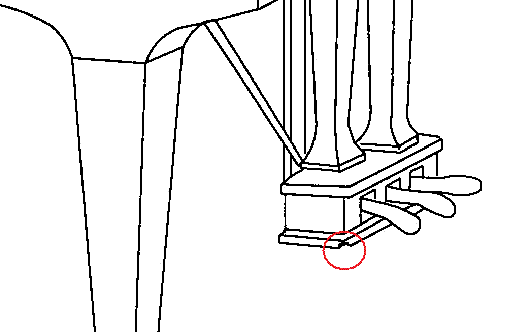
Anyway.
I emailed Steinway Dude about it. He emailed me right back suggesting he could send someone out to look at it or I could send him a photo. So I got a couple of pix and it looks like it'll be pretty easy to replace. At first he said he'd need to take the lyre for two days. Man, my heart dropped. The thought of going without pedals for two days was totally depressing. I half considered calling off the repair so that I wouldn't have to part with the lyre. But the exposed screw scares me a bit from a structural point of view:
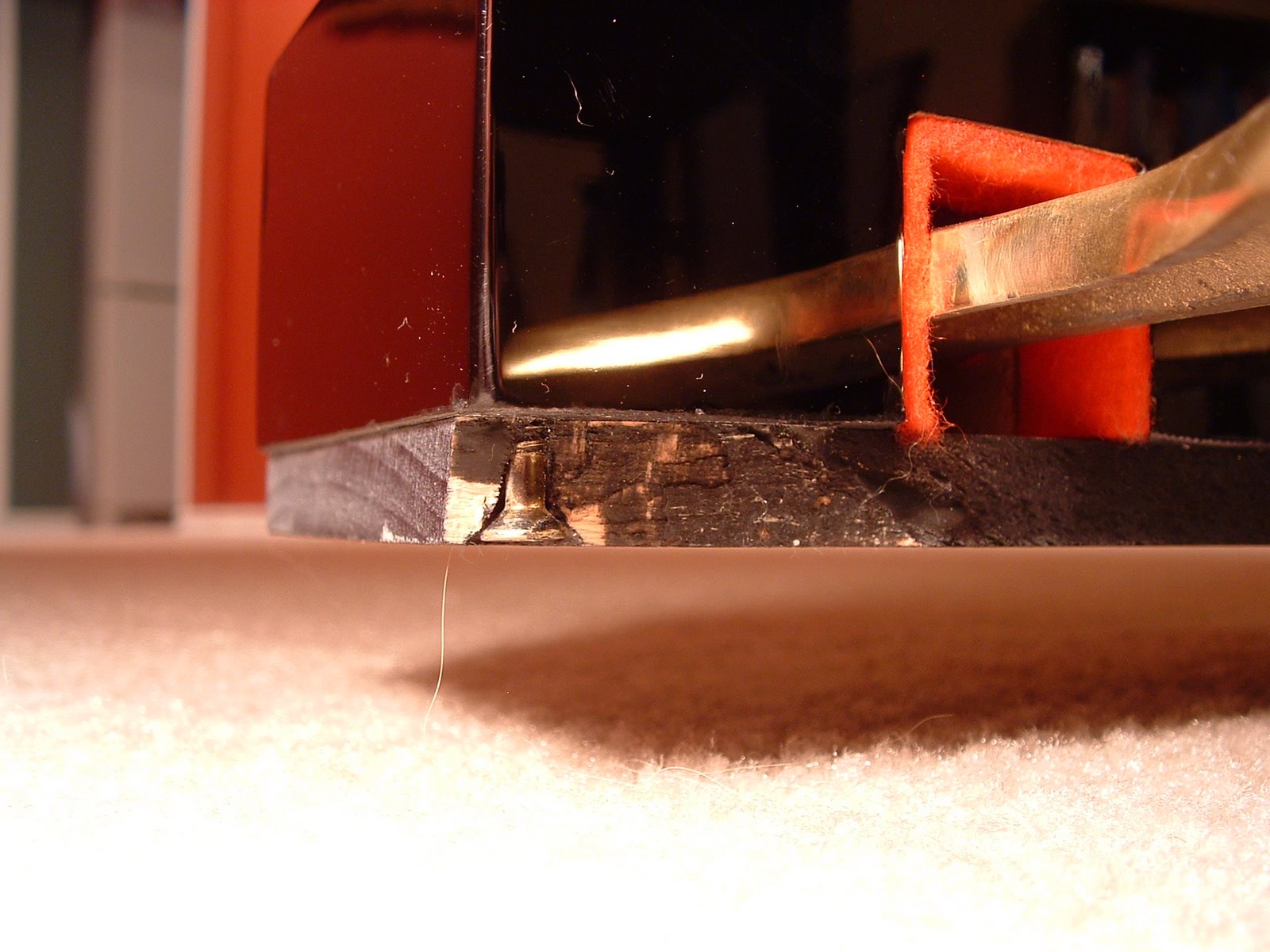
Luckily, S. Dude discovered he has a spare lyre bottom and he can replace it on site in about a half an hour. So he'll come and fix it Friday morning. I'll let you know how it goes.
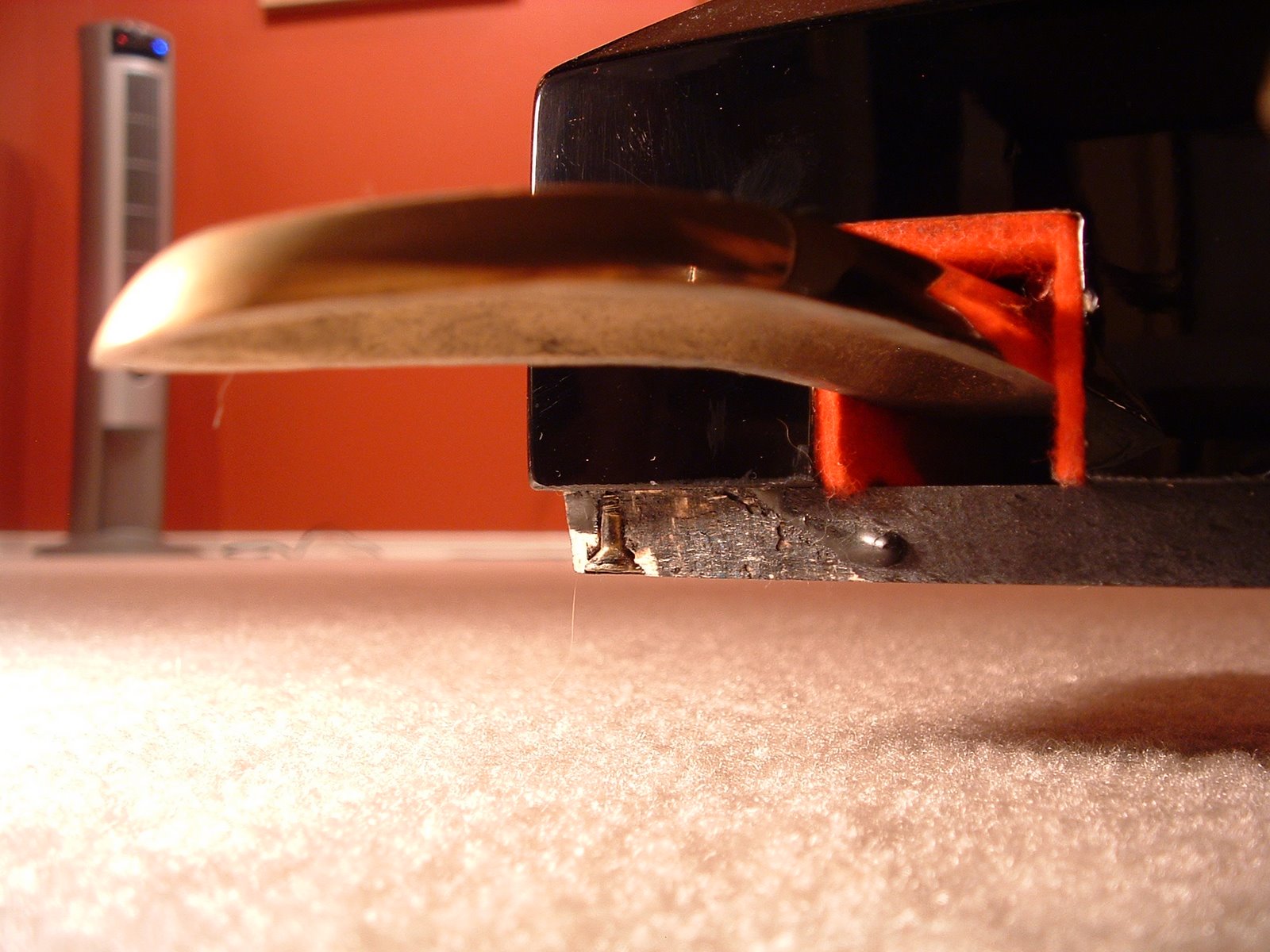
I noticed the other day that the wood of my lyre bottom is chipped in the front corner on the una corda side.
"What's a lyre bottom?", you ask? Luckily, it's probably the most unimportant part of the piano. It's a rectangle of unfinished wood screwed to the bottom of the lyre (the pedal contraption thing). See the schematic:

Anyway.
I emailed Steinway Dude about it. He emailed me right back suggesting he could send someone out to look at it or I could send him a photo. So I got a couple of pix and it looks like it'll be pretty easy to replace. At first he said he'd need to take the lyre for two days. Man, my heart dropped. The thought of going without pedals for two days was totally depressing. I half considered calling off the repair so that I wouldn't have to part with the lyre. But the exposed screw scares me a bit from a structural point of view:

Luckily, S. Dude discovered he has a spare lyre bottom and he can replace it on site in about a half an hour. So he'll come and fix it Friday morning. I'll let you know how it goes.

Monday, June 2, 2008
More Piano Pix
Friday, May 30, 2008
Delivery Day!
Steinway promised to show up sometime between 10am and 11am, which is ok because I had a few things to do in preparation for the piano's arrival. The truck rolled up at about 9:45am and left less than a half hour later. Raymond and his assistant have done this before. This chronicle is a little lengthy and bloated with photos (and even video!). So let's get started.
It's here! It's here! I can only hope that everyone reading this will someday experience the thrill I got having a Steinway truck outside my house.

The movers are quick and efficient, but handle my newborn with great care. There's nothing sloppy about the way they move... you can tell they're watching every corner and bump.

Through the front door...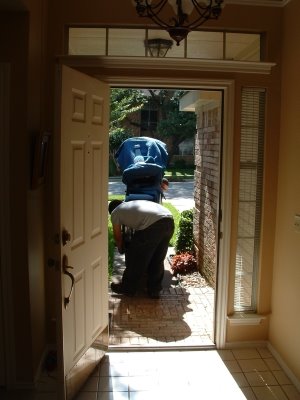
...and into the gallery. The legs latch into position and are then tightened by hand. But to make sure they're tightly latched, the movers whale on them with this huge Thor's Hammer. Raymond is at the beginning of a full-arm swing at the treble leg here.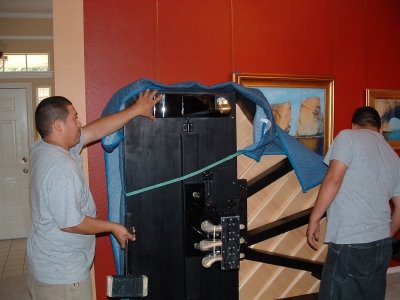
Once the tail leg, treble leg and lyre are secure, they tilt the piano over into position before attaching the bass leg.
A couple more thumps by Thor and the bass leg is in place.
The piano is up. Raymond, please put away that hammer. I don't think my heart can take any more piano bashing.
But does it play well? Heck ya! (Our dog Maple seems to like it, too).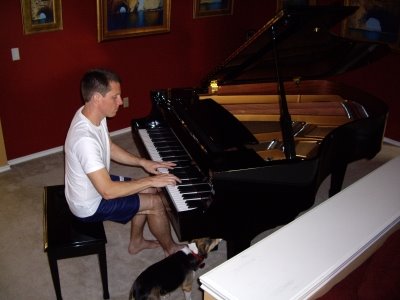
Who's a good dog? Who's a good dog!? I may be biased, but I think Maple kicks the RCA Victor dog's butt. And that's Kashmir on the half-wall trying to get up the nerve to jump inside for a closer look. If a thing has an inside and an outside, Kashmir prefers the inside.
Shiner finally decides to grace us. In the video he's trying to pretend he doesn't even notice the sudden appearance of the huge monolith that all the other apes are obsessed with. But as cool as he is, he still has to sneak a look as he passes by. Watch it again and notice Kashmir trying to climb inside from beneath this time.
It's here! It's here! I can only hope that everyone reading this will someday experience the thrill I got having a Steinway truck outside my house.

The movers are quick and efficient, but handle my newborn with great care. There's nothing sloppy about the way they move... you can tell they're watching every corner and bump.

Through the front door...

...and into the gallery. The legs latch into position and are then tightened by hand. But to make sure they're tightly latched, the movers whale on them with this huge Thor's Hammer. Raymond is at the beginning of a full-arm swing at the treble leg here.

Once the tail leg, treble leg and lyre are secure, they tilt the piano over into position before attaching the bass leg.
A couple more thumps by Thor and the bass leg is in place.
The piano is up. Raymond, please put away that hammer. I don't think my heart can take any more piano bashing.

But does it play well? Heck ya! (Our dog Maple seems to like it, too).

Who's a good dog? Who's a good dog!? I may be biased, but I think Maple kicks the RCA Victor dog's butt. And that's Kashmir on the half-wall trying to get up the nerve to jump inside for a closer look. If a thing has an inside and an outside, Kashmir prefers the inside.

Shiner finally decides to grace us. In the video he's trying to pretend he doesn't even notice the sudden appearance of the huge monolith that all the other apes are obsessed with. But as cool as he is, he still has to sneak a look as he passes by. Watch it again and notice Kashmir trying to climb inside from beneath this time.
Thursday, May 29, 2008
Piano 101: Coda
When I decided to start practicing again and build a program, I had no idea how obsessed I would become with the piano. I want to play them all.
I've had fun practicing, performing a little and recording some pieces to post here for family and friends. It's all been an absolute joy for me.
Hanging out at the Steinway Gallery was a roller coaster. Playing all those great pianos was a real high, but there was no way I would ever be able to get one. The less expensive Bostons were beautiful, but still out of reach. And there was no shortage of other good pianos I couldn't afford either. I finally got curious enough to ask about Steinway's relatively inexpensive "third string" line: the Essex. Like the "second string" Boston, these are pianos that are designed and sold by Steinway, but manufactured for them in Asia: Boston by Kawai in Japan and Essex by Young Chang in Korea (with one or two models built in China by Pearl River).
The biggest Essex is the 183, at just a sliver over six feet. It shares many of the design features of the Bostons and Steinways, including the wide tail of the four longest Steinways. I was really impressed with the 183, although the voicing and action of the floor model was a little uneven. When I mentioned it to my Steinway guy, he said he'd have his tech do some work on it. Over the next month, I went in every weekend to play it and give my impressions. And every week the tech would work on it some more. The tone and playability turned out exceptional. So the Steinway Gallery ended up with a floor piano set up exactly to my tastes... and a piano that I couldn't live without.
After more financing obstacles than I care to rehash, giving up expensive coffee, Trappist beer and ice hockey, I was able to work it out. Steinway delivers my brand new Essex EGP-183 tomorrow morning. My own piano. I'm so excited, I think I will barf.
So even though Piano 101 has come to an end, I expect that my new piano will inspire many posts to come. Stay tuned!
I've had fun practicing, performing a little and recording some pieces to post here for family and friends. It's all been an absolute joy for me.
Hanging out at the Steinway Gallery was a roller coaster. Playing all those great pianos was a real high, but there was no way I would ever be able to get one. The less expensive Bostons were beautiful, but still out of reach. And there was no shortage of other good pianos I couldn't afford either. I finally got curious enough to ask about Steinway's relatively inexpensive "third string" line: the Essex. Like the "second string" Boston, these are pianos that are designed and sold by Steinway, but manufactured for them in Asia: Boston by Kawai in Japan and Essex by Young Chang in Korea (with one or two models built in China by Pearl River).
The biggest Essex is the 183, at just a sliver over six feet. It shares many of the design features of the Bostons and Steinways, including the wide tail of the four longest Steinways. I was really impressed with the 183, although the voicing and action of the floor model was a little uneven. When I mentioned it to my Steinway guy, he said he'd have his tech do some work on it. Over the next month, I went in every weekend to play it and give my impressions. And every week the tech would work on it some more. The tone and playability turned out exceptional. So the Steinway Gallery ended up with a floor piano set up exactly to my tastes... and a piano that I couldn't live without.
After more financing obstacles than I care to rehash, giving up expensive coffee, Trappist beer and ice hockey, I was able to work it out. Steinway delivers my brand new Essex EGP-183 tomorrow morning. My own piano. I'm so excited, I think I will barf.
So even though Piano 101 has come to an end, I expect that my new piano will inspire many posts to come. Stay tuned!
Tuesday, May 27, 2008
Piano 101: 10. Sonetto 104 del Petrarca
Franz Liszt published some of his greatest solo piano music in three volumes he called Années de Pèlerinage (Years of Pilgrimage). The second year ("Italy") includes three pieces inspired by the Italian poet Petrarch. Sonetto 104 del Petrarca will be my final recording in this series. So sad.
The piece is one of my all-time favorites. It really showcases the piano, with singing melody, percussion, lush orchestral voicing and shimmering effects. I loved playing it years ago and I love it even more now.
Track 10: Sonetto 104 del Petrarca (Franz Liszt)
The piece is one of my all-time favorites. It really showcases the piano, with singing melody, percussion, lush orchestral voicing and shimmering effects. I loved playing it years ago and I love it even more now.
Track 10: Sonetto 104 del Petrarca (Franz Liszt)
Sunday, May 11, 2008
Piano 101: 9. Toccata pour le Piano Opus 54
Jenö Takács was a twentieth century Austrian composer. According to my Austrian edition (Doblinger), this piece was written in 1946. The metronome marking is 96-108 half notes per minute. And as if anticipating our disbelief, the composer also notes that the total performance time is around four minutes. The composer's insistence notwithstanding, I couldn't bring myself to record it that fast. So my version has parts that get up to 96, but mostly hangs down in the low 90s or high 80s.
I decided to include this piece because my uncle Marty liked it so much. He came to visit us in Ottawa one time and I played it for him. He suggested that after finishing the piece, I should leap up, kick over the bench, knock out the lid prop and slam down the fallboard. I never took him up on his choreography, but from that point on I couldn't play the piece without it crossing my mind.
Track 9: Toccata pour le Piano Opus 54 (Jenö Takács)
I decided to include this piece because my uncle Marty liked it so much. He came to visit us in Ottawa one time and I played it for him. He suggested that after finishing the piece, I should leap up, kick over the bench, knock out the lid prop and slam down the fallboard. I never took him up on his choreography, but from that point on I couldn't play the piece without it crossing my mind.
Track 9: Toccata pour le Piano Opus 54 (Jenö Takács)
Saturday, April 26, 2008
Piano 101: 8. Impromptu Opus 90 Nr. 4
I broke the rules on this one. These were supposed to be recordings of pieces I used to play many years ago, but I never played this one before this year.
Schubert's Impromptu is a piece that my mother used to play. Some of my earliest memories are of her playing it on her old Chopin upright piano. I couldn't have been more than four or five years old. But it was one of the pieces that got me interested in learning the piano and has stuck with me all these years.
I'm sure my father will recognize this piece, and probably my brothers and sister, too. But I wonder if any of my mother's brothers and sisters remember her playing it. I would love to hear any reminiscences.
Track 8: Impromptu Opus 90 Nr. 4 (Franz Schubert)
Schubert's Impromptu is a piece that my mother used to play. Some of my earliest memories are of her playing it on her old Chopin upright piano. I couldn't have been more than four or five years old. But it was one of the pieces that got me interested in learning the piano and has stuck with me all these years.
I'm sure my father will recognize this piece, and probably my brothers and sister, too. But I wonder if any of my mother's brothers and sisters remember her playing it. I would love to hear any reminiscences.
Track 8: Impromptu Opus 90 Nr. 4 (Franz Schubert)
Sunday, March 23, 2008
Piano 101: 7. Arabesque I
Debussy's Arabesque I was probably the first piece I learned that you'd consider "concert repertoire". It must have been around 1982 or 1983, I think. The piece is an example of French Impressionist music, known for its suggestion of atmosphere. But I had a lot of trouble trying to capture the tranquility and mood in a recording. Nonetheless, it's one of my all-time favorite pieces to play. It feels like making music.
Track 7: Arabesque I (Claude Debussy)
Track 7: Arabesque I (Claude Debussy)
Friday, March 7, 2008
Piano 101: 6. Danza del Gaucho Matrero
The final Argentinian Dance is the Dance of the Cunning Cowboy. The opening instruction on the score is "Furiosamente ritmico e energico" ("furiously rhythmic and energetic"), and it doesn't let up from beginning to end. You really have to work out how to keep the energy up without hammering on every note, because your arms won't make it to the end. I've found that stressing the inner voices in the big chords gives power and brings out the melody while avoiding exhaustion.
There are plenty of examples of the 2x3 vs. 3x2 rhythm throughout, as well as a new twist in the chordal melody sections where Ginastera inserts some bars of 9/8 among the 6/8. That adds a 3x3 grouping to the mix. There are a few other bizarre accent patterns that can completely throw your timing if you're not careful.
Anyway. Strap on your seatbelt...
Track 6: Danza del Gaucho Matrero (Alberto Ginastera)
There are plenty of examples of the 2x3 vs. 3x2 rhythm throughout, as well as a new twist in the chordal melody sections where Ginastera inserts some bars of 9/8 among the 6/8. That adds a 3x3 grouping to the mix. There are a few other bizarre accent patterns that can completely throw your timing if you're not careful.
Anyway. Strap on your seatbelt...
Track 6: Danza del Gaucho Matrero (Alberto Ginastera)
Wednesday, January 30, 2008
Piano 101: 5. Danza de la Moza Donosa
The second of Ginastera's Argentinian Dances is the Dance of the Graceful Maiden. And I LOVE this piece... the close chromaticism in the melody... the wide open intervals in the harmony.
There isn't a lot of rhythmic action, but a classic accent figure from Spanish music appears a couple of times. The 6/8 bars are mostly accented 1-2-3-1-2-3 but Ginastera occasionally throws in a bar accented 1-2-1-2-1-2. The most obvious examples are at 1:29 and 2:01. You can hear the effect by reciting this little poem:
Muffin with Marmelade
Muffin with Marmelade
Muffin with Marmelade
Muffin Muffin Muffin
This figure also appears all over the place in Albéniz' El Puerto and in the other two Argentinian Dances.
Track 5: Danza de la Moza Donosa (Alberto Ginastera)
There isn't a lot of rhythmic action, but a classic accent figure from Spanish music appears a couple of times. The 6/8 bars are mostly accented 1-2-3-1-2-3 but Ginastera occasionally throws in a bar accented 1-2-1-2-1-2. The most obvious examples are at 1:29 and 2:01. You can hear the effect by reciting this little poem:
Muffin with Marmelade
Muffin with Marmelade
Muffin with Marmelade
Muffin Muffin Muffin
This figure also appears all over the place in Albéniz' El Puerto and in the other two Argentinian Dances.
Track 5: Danza de la Moza Donosa (Alberto Ginastera)
Saturday, January 19, 2008
Piano 101: 4. Danza del Viejo Boyero
Or Dance of the Old Cowherd, although I can't imagine anybody dancing to this piece, much less an old cowherd.
Viejo Boyero is the first of three pieces that make up Alberto Ginastera's Danzas Argentinas. These three were among the last pieces I studied with Douglas Voice.
Listen for the six long notes at the end: they're the notes of the six open strings of a guitar.
Track 4: Danza del Viejo Boyero (Alberto Ginastera)
Viejo Boyero is the first of three pieces that make up Alberto Ginastera's Danzas Argentinas. These three were among the last pieces I studied with Douglas Voice.
Listen for the six long notes at the end: they're the notes of the six open strings of a guitar.
Track 4: Danza del Viejo Boyero (Alberto Ginastera)
Sunday, January 6, 2008
Piano 101: 3. Villanesca
Villanesca was probably my first exposure to the Spanish piano repertoire. My score has pencil markings from both Edith Orton and Jean-Paul Sevilla, suggesting that I worked on this piece toward the very end of my time with Mrs. Orton. That's when she was sending me occasionally to study with Jean-Paul and Douglas. Probably around 1984.
There's something so compelling about the mood of this piece to me. I always come back to it, and it always affects me. I think it's probably a combination of the stately, foreign sounds and my history with the piece.
I never studied much of the story of Enrique Granados. I know he was a Catalonian composer from around the turn of the century (19th to 20th). He's best known for his Goyescas suite, not the Spanish Dances suite from which Villanesca comes. I might get around to recording one of the Goyescas pieces eventually. We'll see.
Track 3: Villanesca (Enrique Granados)
There's something so compelling about the mood of this piece to me. I always come back to it, and it always affects me. I think it's probably a combination of the stately, foreign sounds and my history with the piece.
I never studied much of the story of Enrique Granados. I know he was a Catalonian composer from around the turn of the century (19th to 20th). He's best known for his Goyescas suite, not the Spanish Dances suite from which Villanesca comes. I might get around to recording one of the Goyescas pieces eventually. We'll see.
Track 3: Villanesca (Enrique Granados)
Tuesday, January 1, 2008
Piano 101: 2. Étude Opus 10 Nr. 3
If I had to guess, I'd say the piece I performed the most over the years was this Chopin Étude. Its nickname is "Tristesse", but I don't really find it sad. Maybe it's a little wistful.
The Chopin Études were intended to present technical exercises to students in the natural setting of enjoyable music. Chopin accomplished this blend so successfully that the Études have become part of the solo piano concert repertoire. The exercise in this piece is right-hand self-accompaniment. The right hand is playing two parts simultaneously: the obvious melody and a chordal accompaniment. The goal is to make the melody sing, standing out from the accompaniment, even though they're being played with one hand.
Track 2: Étude Opus 10 Nr. 3 (Frédéric Chopin)
The Chopin Études were intended to present technical exercises to students in the natural setting of enjoyable music. Chopin accomplished this blend so successfully that the Études have become part of the solo piano concert repertoire. The exercise in this piece is right-hand self-accompaniment. The right hand is playing two parts simultaneously: the obvious melody and a chordal accompaniment. The goal is to make the melody sing, standing out from the accompaniment, even though they're being played with one hand.
Track 2: Étude Opus 10 Nr. 3 (Frédéric Chopin)
Subscribe to:
Posts (Atom)


